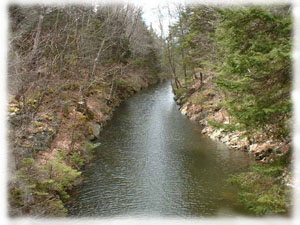Used
by the native Mi'kmaq for centuries, the Shubenacadie
waterway was carved out of bedrock by glaciers
during the last ice age.
| Work
on the canal system began in 1826, ceased
in 1831 and resumed in 1854. The canal
was completed in 1861. Construction of
9 locks and 2 inclined planes connected
a chain of 7 lakes and the Shubenacadie
River, enabling boats to travel from Halifax
Harbour to the Minas Basin. The only other
route to the Bay of Fundy was by way of
Cape Sable, a dangerous sail. |
 |
 |
The
famous "deep cut" between
Lake MicMac and Lake Charles was the
single most expensive and time consuming
piece of work in the entire canal. It
could not be finished in a single work
season and was hard to protect from
the destruction of winter. It was a
cut into the bedrock over a kilometer
long and at least four feet deep.
|
The
Shubenacadie Canal opened in sections and
operated between 1856 and 1870. Steam vessels
hauled barges laden with goods along the system.
The canal moved goods needed for gold mining
to Waverley which included machinery and coal
from Dartmouth. Lumber, bricks, and granite
from the Grand Lake area were also transported
through the canal.
By 1870, railways were able to transport goods
faster and more cheaply than ships.
People's
view of the canal as a viable method of transportation
changed and the new railway was deemed superior.
The canal was used in the construction of
the railway and the low railway bridges that
forced its closure in 1870.
The
Shubenacadie Canal System is now a National
Historic Civil Engineering site and a popular
recreation and heritage corridor. The canal
offers a wonderful wilderness experience for
hikers and canoeists alike.
|